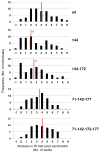Glycosylations in the globular head of the hemagglutinin protein modulate the virulence and antigenic properties of the H1N1 influenza viruses
- PMID: 23720581
- PMCID: PMC3940933
- DOI: 10.1126/scitranslmed.3005996
Glycosylations in the globular head of the hemagglutinin protein modulate the virulence and antigenic properties of the H1N1 influenza viruses
Abstract
With the global spread of the 2009 pandemic H1N1 (pH1N1) influenza virus, there are increasing worries about evolution through antigenic drift. One way previous seasonal H1N1 and H3N2 influenza strains have evolved over time is by acquiring additional glycosylations in the globular head of their hemagglutinin (HA) proteins; these glycosylations have been believed to shield antigenically relevant regions from antibody immune responses. We added additional HA glycosylation sites to influenza A/Netherlands/602/2009 recombinant (rpH1N1) viruses, reflecting their temporal appearance in previous seasonal H1N1 viruses. Additional glycosylations resulted in substantially attenuated infection in mice and ferrets, whereas deleting HA glycosylation sites from a pre-pandemic virus resulted in increased pathogenicity in mice. We then more directly investigated the interactions of HA glycosylations and antibody responses through mutational analysis. We found that the polyclonal antibody response elicited by wild-type rpH1N1 HA was likely directed against an immunodominant region, which could be shielded by glycosylation at position 144. However, rpH1N1 HA glycosylated at position 144 elicited a broader polyclonal response able to cross-neutralize all wild-type and glycosylation mutant pH1N1 viruses. Moreover, mice infected with a recent seasonal virus in which glycosylation sites were removed elicited antibodies that protected against challenge with the antigenically distant pH1N1 virus. Thus, acquisition of glycosylation sites in the HA of H1N1 human influenza viruses affected not only their pathogenicity and ability to escape from polyclonal antibodies elicited by previous influenza virus strains but also their ability to induce cross-reactive antibodies against drifted antigenic variants.
Conflict of interest statement
Figures






References
-
- Molinari NA, Ortega-Sanchez IR, Messonnier ML, Thompson WW, Wortley PM, Weintraub E, Bridges CB. The annual impact of seasonal influenza in the US: measuring disease burden and costs. Vaccine. 2007;25:5086–5096. - PubMed
Publication types
MeSH terms
Substances
Grants and funding
LinkOut - more resources
Full Text Sources
Other Literature Sources

